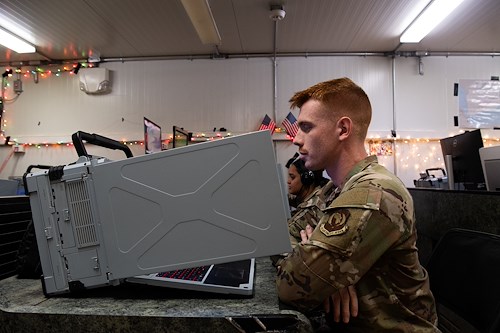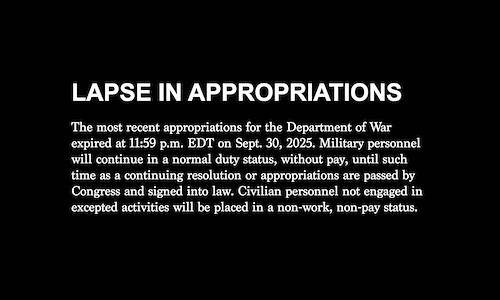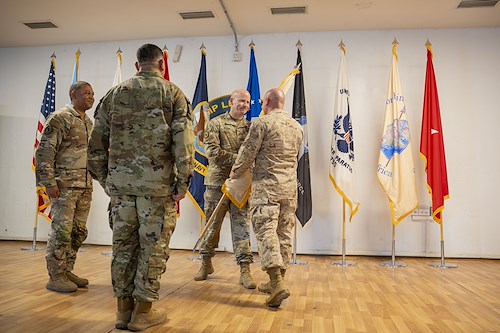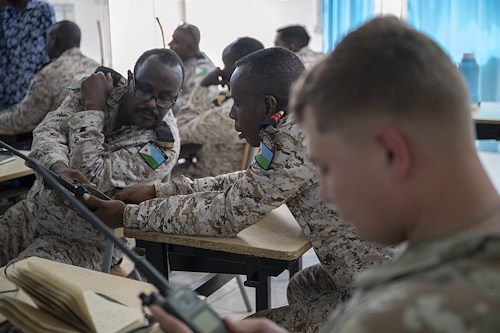Gallery contains 4 images
×
Photo 1 of 4
Combined Joint Task Force - Horn
U.S. Air Force Senior Airman Christopher King, 606th Air Control Squadron mission support operator, works on the Tactical Operations Control - Light command and control system at Camp Lemonnier, Djibouti, Feb. 17, 2025. The TOC-L system is a new command-and-control node designed to be rapidly deployable and maneuverable with the purpose of allowing the battle management team and sensor operators the ability to build and provide a common operating tactical air picture that assists with ensuring the safety deconfliction of flight for friendly and civilian aircraft in the area of responsibility. (U.S. Air Force photo by Staff Sgt. Noah Sudolcan)
Photo by: CJTF-HOA Public Affairs
Photo 2 of 4
Combined Joint Task Force - Horn
U.S. Air Force Staff Sgt. Michael Woods, 606th Air Control Squadron NCO In Charge of radio and network operations and U.S. Air Force Senior Airman Isaac Brookens, 606th ACS radio operations technician, work on the Tactical Operations Control - Light command and control system at Camp Lemonnier, Djibouti, Feb. 17, 2025. The TOC-L system is a new command-and-control node designed to be rapidly deployable and maneuverable with the purpose of allowing the battle management team and sensor operators the ability to build and provide a common operating tactical air picture that assists with ensuring the safety deconfliction of flight for friendly and civilian aircraft in the area of responsibility. (U.S. Air Force photo by Staff Sgt. Noah Sudolcan)
Photo by: Staff Sgt. Noah Sudolcan
Photo 3 of 4
Combined Joint Task Force - Horn
U.S. Air Force Airman 1st Class Phillip Castelan and Senior Airman Penelope Fernandez Velez, 606th Air Control Squadron network operations technicians, work on the Tactical Operations Control - Light command and control system at Camp Lemonnier, Djibouti, Feb. 17, 2025. The 606th Air Control Squadron, callsign “Primo,” is a mobile Command and Control combat unit “Ready Now” to meet our Nation’s call for exceptional tactical command and control. (U.S. Air Force photo by Staff Sgt. Noah Sudolcan)
Photo by: Staff Sgt. Noah Sudolcan
Photo 4 of 4
Combined Joint Task Force - Horn
U.S. Air Force members assigned to the 606th Air Control Squadron perform their daily tasks on the Tactical Operations Control - Light command and control system at Camp Lemonnier, Djibouti, Feb. 17, 2025. The 606th Air Control Squadron, callsign “Primo,” is a mobile Command and Control combat unit “Ready Now” to meet our Nation’s call for exceptional tactical command and control. (U.S. Air Force photo by Staff Sgt. Noah Sudolcan)
Photo by: Staff Sgt. Noah Sudolcan
CAMP LEMONNIER, Djibouti-- In November, Airmen from the 606th Air Control Squadron deployed from Aviano Air Base, Italy, to Camp Lemonnier, Djibouti, to assume authority of control and reporting center responsibilities for Combined Joint Task Force – Horn of Africa from U.S. Marine Air Control Squadron 2's Tactical Air Operations Center.
With the transition, the 606 ACS implemented the Tactical Operations Center-Light system for the first time in a deployed environment.
The TOC-L system is a new command-and-control node designed to be rapidly deployable and maneuverable to allow the battle management team and sensor operators the ability to build and provide a common operating tactical air picture that assists with ensuring safety and deconfliction of flight for friendly and civilian aircraft in the area of responsibility.
“We must be ready to deploy rapidly to meet rising threats,” said Gen. James B. Hecker, U.S. Air Forces Europe-Air Forces Africa commander. “Getting the right training and equipment for our Airmen is critical to empower them to fight and win in contested, degraded environments.”
Another advantage for tactical command and control for the new TOC-L system is the ability to ingest information from host nations radars, which has not always been a capability for the unit. Interoperability with allies and partners substantially improves operational resilience and flexibility, creating dilemmas for adversaries.
“TOC-L is a big difference, it’s a game changer,” said Senior Airman Appolonia Meynisse, 606 ACS network operations technician. “It’s more compute, more compact, more scalable, flexible and easy to use.”
The TOC-L system’s advantages doesn’t stop there, it also has the ability to fit into the Air Force’s Agile Combat Employment initiative. ACE is a key operating concept for how we will fight in a modern, contested, competitive environment. The collaboration and integration with our allies and partners improves the resilience and survivability of coalition airpower.
“This allows us to direct appropriate air defense, whether that be weapons or other kinetic resources available to us,” said Senior Airman Anthony DiDuro, 606th ACS weapons director. “We are able to ensure a swift response due to the systems capabilities.”
The TOC-L, though not light, can be moved and transported with ease, enabling Airmen to employ it’s capabilities around the world.
“Having to rapidly deploy the kit is probably the biggest impact on not just the unit, but the Air Force as a whole,” said Meynisse. “The kit allows us to rapidly deploy, relocate and operate in numerous conditions.”
The need for a new Tactical Operations Center system comes as the Air Force better prepares itself to fight and win in large-scale combat operations, where units would have to rapidly deploy to and from contested, degraded environments against potential near-peer adversaries.
“The purpose of the change to the TOC-L is to execute Air Combat Command’s vision to evolve today’s Theater Air Control System to tomorrow’s Air Component Control System,” said DiDuro.
The role DiDuro has in the 606 ACS is to provide technical air control and situational awareness enhancing, allowing their number one priority of air defense in Djibouti, Africa, to be accomplished.
The 606th Air Control Squadron, callsign “Primo,” is a mobile Command and Control combat unit “Ready Now” to meet our Nation’s call for exceptional tactical command and control.
















